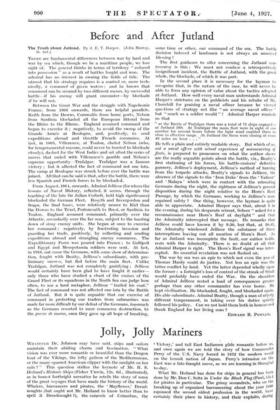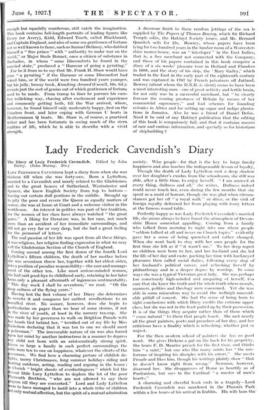Jolly, Jolly Mariners
WHATEVER Dr. Johnson may have said, ships and sailors maintain their abiding charm and fascination. " What vision was ever more romantic or beautiful than the Dragon boat of the Vikings, the lofty galleon of the Mediterranean, or the many-sparred American clipper with the sunlight on her sails ? " This question strikes the keynote of Mr. R. S. Holland's Historic Ships (Fisher Unwin, 12s. 6d., illustrated), as in honest forthright narrative he retells, the story of SQ/11e, of the great voyages that have made the history of the world. Whalers, buccaneers and pirates, the ' Mayflower,' Dread- noughts (but, ought not Mr. Holland to know better than-to spell it Dreadnaught ?), the caravels of Columbus,. the
Victory,' and tall East Indiamen glide romantic before us, and once again we are told the story of how Commander Perry of the U.S. Navy forced in 1852 the modern world on the hermit nation of Japan. Perry's intrusion on the East was a fate-fraught move, as we are learning in Shanghai to-day.
What Mr. Holland has done for ships in general has been done by Mr. Don C. Seitz in Under the Black Flag (Paul, 150 for pirates in particular. The grimy scoundrels, who on the breaking , up of organized buccaneering about the year 1680 espoused the second oldest - profession in the world, have certainly their place in history, and their exploits, daring
enough but squalidly murderous, still catch the imagination. This book contains full-length portraits of leading figures like Every (or Avery), Kidd, Edward Teach, called Blackbeard, and Captain England, and also of some sea gentlemen of fortune not so well known to fame, such as Samuel Bellamy, who dubbed himself a " free prince " with " authority to make war on the world," or Major Stede Bonnet, once a citizen of substance in Barbados, in whom " some Discomforts he found in the married state," produced a " Humour of going a pyrating:'
Far be it from us to say that Mr. Frank H. Shaw would have gone " a pyrating " if the Humour or some Discomfort had seized him, or if the world were two hundred years younger, but his jolly, breezy book, Knocking Around (Cassell, 10s. 6d.); reveals just the sort of genius out of which gentlemen of fortune used to be made. From tramp to liner he pursues his care- free rollicking way, chasing after excitement and experience and commonly getting both, till the War arrived, where, however, he found himself only moderately happy, first on the Flanders front, and later coping with German U boats in Mediterranean Q boats. Mr. Shaw is, of course, a practised writer and has been fortunate in seeing much of the stern realities of life, which he is able to describe with a vivid strength. A decorous finish to these random jottings of the sea is supplied by The Papers of Thomas Borcrey, which Sir Richard Temple edits, the Hakluyt Society issues, and Mr. Bernard Quaritch sells for 25s. Bowrey, whose papers have been lying for two hundred years in the lumber room of a Worcester- shire manor-house, was an " interloper " in the East Indies; that is, a free merchant not connected with the Company; and those of his papers contained in this book comprise a diary of a six weeks' pleasure tour in Holland and Flanders in 1698, and the story of his ship, the Mary Galley,' which traded in the East in the early part of the eighteenth century and was captured in 1707 by French privateers off Jutland: Bowrey (about whom the D.N.B. is silent) seems to have been a most interesting man—one of great activity and fertile brain, for not only was he a successful merchant, but " lie clearly foresaw the coining greatness of Britain by means of her commercial supremacy," and had schemes for founding colonies in Africa and for setting up sugar and indigo planta- tions in Jamaica. Also he was a friend of Daniel Defoe. Need it be said of any Hakluyt publication that the editing of this book is scrupulously full, and that it contains masses of rare and curious information, and specially so for historians of shipbuilding ?







































 Previous page
Previous page